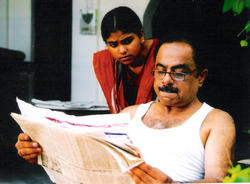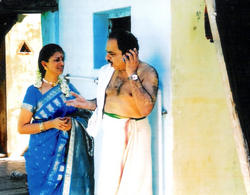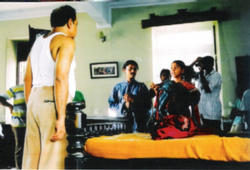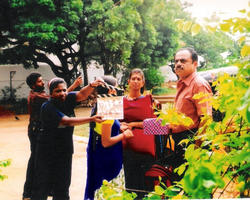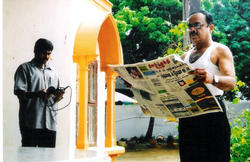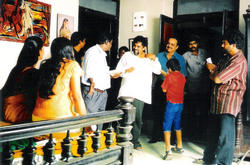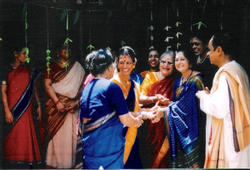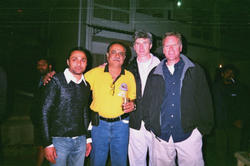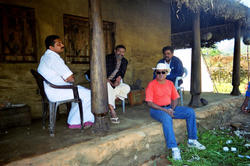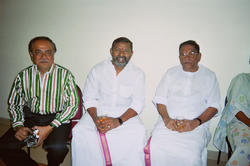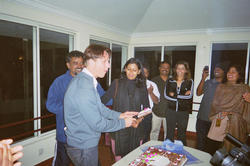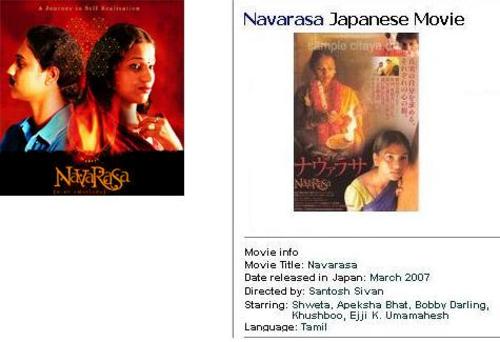EJJI IN MOVIES
MY FILM ROLES
I am not a professional actor. Like my life in theatre, it was something different that I wanted to try. I did not do any film for a fee. Whenever a fee was paid, I gave it to a charity that the producer recommended.
AAYUDHA EZHUTHU (Tamil feature film)
Mani Ratnam's "Aayudha Ezhuthu" was my first film role. A small cameo appearance, I act as the principal of a college where the lead actors study. It was a pleasure being on the sets with Mani, though I know him more as the brother of my good friend (late) G.Venkateswaran (GV). For the first time in my life, I saw a film being made. It was a different experience, having been used to stage acting. Mani emphasizes the fact that he wants everything to be natural. No "acting" for him. He asks you to just imagine how that scene would happen in real life. His forte is to make things happen on the screen that the viewer will intrinsically identify to be an every day happening. So different from the run of the mill movies made in India, where artificiality is the essence of good acting. Photos at https://plus.google.com/photos/101850974532416984179/albums/5767946708765690449
NAVARASA (Tamil feature film) - NINE EMOTIONS (English version)
My next experience was after I was introduced to Santosh Sivan. Santosh I found was a very unassuming person, whose fame sits lightly on his shoulders. A loner, who shuns media attention (and is uncomfortable when attention is poured on him), a non-conformist, keen observer of human behavior, he found my "tangential thinking" and my theory that "normal is boring" to be the only admirable things in me. He had researched thoroughly on the third gender and was making "Navarasa" on the subject. He heard about my making a home video on the Koovagam Festival some years ago. He saw my non-professional video film, and gave me a good role in his movie. Shooting with Santosh was fun. A person who, in spite of his exalted knowledge of filmmaking, would ask anyone and everyone involved with the film for inputs. And he took the best of inputs with no airs, to incorporate in his film. Humility personified! A magician with light and camera angles, he has the uncanny ability to think in his mind what the view finder will capture even before he puts his eye to the view finder. Navarasa turned out to be a very artistic movie. I feel most Indians per se were not mentally tuned to appreciate a classic work of this type. Navarasa was a huge success at most international festivals like Monaco International Film Festival, Lyon Asian Film Festival, France 2005, The Pusan Film Festival 2005, and Rotterdam Film Festival 2005. The elite in India did see and appreciate the movie, though you cannot term it a commercial success in terms of business. Navarasa won the National Award in 2005 for "Best Tamil Feature Film". And in March 2007, it was released in Japan to rave reviews!
View pictures of Navarasa at https://plus.google.com/photos/101850974532416984179/albums/5322904891331538385
Also see http://en.wikipedia.org/wiki/Navarasa_(film)
BEFORE THE RAINS (English feature film)
My next film was again a Santosh Sivan film. With the working title "Kerala", Santosh directed it and he was also the cinematographer. It opened a new world for me. Produced by Echo Lake Productions, in the U.S., it was premiered at the Toronto Film Festival in September 2007 under the title "Before the Rains". The film stars Linus Roach, Jennifer Eyle, Sir John Standing, Rahul Bose, Nanditha Das and Indrajit. Entirely shot in Munnar (Kerala), it showed how efficiency could be the backbone of a production. A shooting schedule that was so finely tuned to ultimate perfection before the start of the first shot, that it is hard to believe that the shooting ended after two months exactly to the minute as scheduled. A whole tribal village was set up at Munnar, with bridges, temple, public square, river that was partially diverted through the set....... the works. My role is that of Inspector Sampath, the Inspector of Police, Munnar. The story is a murder mystery that happens in Munnar, circa 1934. The two-month schedule was so business-like, with get-togethers every weekend. All the compliments must go to the producers whose grasp of logistics, timing and teamwork was something that can be compared to a space launch by NASA!! Photos of Before the Rains at https://plus.google.com/photos/101850974532416984179/albums/5779448846583612049 and Making of Before the Rains at https://plus.google.com/photos/101850974532416984179/albums/5322899740717843969
Read about the movie at http://www.mediafire.com/view/?58bs5ci51tszxn3
Also see http://en.wikipedia.org/wiki/Before_the_Rains
VAAZHKAI INIDHU VAAZHVOM INIDU (Tamil documentary)
I have done a role in a "Public Service" film on diabetes in Tamil. A short film, it shows that diabetes can be successfully treated, and a diabetic can lead a very healthy life. The story and script was the brainchild of Raaja Chandrasekhar who also collaborated on the screenplay of Navarasa.
MUDHAL MUDHAL MUDHAL VARAI [m3v] (Tamil feature film)
Hare Krsna, again an associate of Santosh Sivan in Navarasa, directed this film. What a fabulous name. There lies a story behind that name. Check out http://www.m3v.asia/ . The film in Tamil with lots of English, with indoor scenes shot in a century old house in Triplicane, Chennai. The story is about a young boy who dreams of making a film, but is castigated by his father with old time values. Ultimately he succeeds in his efforts, and makes his parents proud. This film is too natural to be called a movie. It is contemporary life. It is like seeing life on a screen. Youth will identify themselves with it the moment the film starts. Undoubtedly it will be a commercial success. Krsna, an old friend of mine is the most "unfilmy" film man I have met. A person far ahead of his times, I have known him since the 1970's! He beats the stereotyping of a film man of Chennai in everything. His looks, attire, education, interests and the person he is.
ANDHA SUMMER LEAVILA (French & Tamil short film)
The title translates in English to "During that Summer Holiday". This film is the maiden effort of a group of youngster, mostly from the Film institute at Chennai. It is the story of a young girl of Indian origin who lives in France, now visiting her uncle's family in Chennai, India. All actors are first timers and Alphonse Roy, a big name in wild life filmmaking, shot this short film. Watch film: ANDHA SUMMER LEAVILA
MUSIC VIDEO (English)
A music video for a European label was shot with me. Lovely music, a wide age range of actors from a 10-year-old kid to an 80-year-old man. Very modern in character, the music video was a big hit. Part of the shooting was done in the party room in my house in Chennai.
Shweta & Ejji
Apeksha & Ejji
MAKING OF NAVARASA
MAKING OF NAVARASA
MAKING OF NAVARASA
MAKING OF NAVARASA
SCENE FROM NAVARASA
BEFORE THE RAINS
Rahul Bose & Ejji with the Producers Paul and Andrew
Ejji with (from left) Anto, Lal and Santosh on the sets
AAYUTHA EZHUTHU
ar
Ejji with Lal and Mr. Sivan, father of Santosh
Nandita Das's birthday party at Munnar with Linus Roche
NAVARASA is based on the KOOVAGAM KOOTHANDAVAR FESTIVAL. Recently, I returned from Koovakam, a village 30 km from Villipuram, which plays host to the largest annual gathering of hijras in India. I spent a night on the roof of the Koothandavar temple and watched as an otherwise dormant village transformed itself in a brilliant display of colour, vitality and spirit. Koovakam has come to mean many things to many people. For hijras, it is the most important event of the calendar year, a time when they are reunited with friends, a place where they are given a platform from which they can be seen, heard and applauded, where they get to embody all the things they want to be: woman, bride, Goddess. In Villipuram, which is where they stay during the five-day lead up to the actual festival, they overtake the town, strolling up and down the main streets in bright clothes, with flowers in their hair and bangles on their wrists, frequenting the various roadside restaurants and bars; confusing, teasing, beguiling onlookers about what is true and what is false, what is man, what is woman, and what is the place in between that defies definition. It is precisely their sexual and gender ambiguity, their ability to move within an apparently boundary-less world, that have made them a fascinating community for me to study, and the reason for accompanying a group of them from their home in Perungalathur with a fellow-friend and camera man to document their journey to Koovakam. But four days in Villipuram are enough to realise that Koovakam isn't merely about hijras; although they are the star attraction, how can they not be? Koovakam is about the basic right to express oneself — a startling revelation that has developed from a culture struggling with issues of identity and repression. The trend of moving towards an increasingly dichotomous way of viewing the world, of classifying, pigeon-holing, pinning down all manner of things; be it problem, opinion or concern, in a bi-polar fashion, has created a stultifying atmosphere which gets to be aired out only once in a long while in places like Koovakam. The result is a strange display of exhilarating liberation paired with unsettling sordidness. What is most visible is the intensity of physical experience against the backdrop of spirituality with the ever-present ghost of sexuality hovering about. People come to Koovakam without any apology. They come because it is a time for them to be what they want to be. This includes not only hijras but a vast array of men; homosexual, bi-sexual, straight, cross-dressers, married, single, divorced, college boy, auto-driver, tea-shop owner, businessman — they are all here, walking up and down the streets along with the hijras, mingling and intermingling in various combinations of the aforementioned, physical, spiritual and sexual. For people not taking part in these interactions, the spectacle forces contemplation. At Koovakam, the hijras get to embody all the things they want to be: woman, bride ... What is obvious is that there is a need to address issues of sexuality and gender conflict within the framework of our society, especially with the growing menace of AIDS crashing through the horizon. Koovakam is a microcosm of a country caught in contradiction, because it shows what is right and wrong about our society simultaneously. The fact that hijras are not only treated with respect, but welcomed by the ordinary town-people and village folk during their short stay here every year is heartening proof of how the basic Indian philosophy that envisions a universe boundlessly various, including all possibilities of being, proscribing the notion of plurality of selves and allowing opposites to confront each other without resolution, is still alive and kicking. By the same token, hijras as a community are still struggling to regain their place in the world, denied the most basic rights — the right to own a passport, ration card, property, equal opportunities in the areas of education and employment, simply because they refuse to be categorised as either male or female and wish to claim a third gender for themselves. Hijras have always occupied the fringe of the Indian subconscious, they are accepted without question, even if it is with a mixture of fear, ridicule and contempt, because of their inherited centuries old court history combined with the eternal spring-well of mythology, which constantly affirms and validates their existence, quite unlike their western counterpart, the transsexual, who must resolve sexual anomalies one way or the other without the luxury of floating in man-woman limbo. But acceptance does not mean openness; it could simply mean that you don't care one way or the other because a thing has no bearing on your life. It is the same veil through which we view the problems of poverty, war and disease. Unless problems come steamrolling into our own immediate lives, we don't feel the need to address them. So what does it say about the young, homosexual men who come to Koovakam every year to dress in women's clothes, their parents unaware of their son's double life lead and busy plotting weddings with girls who are equally uninformed? What does it say about the hundreds of straight young men who flock to Villipuram because sex is cheap and easily available? This is not an attack on men, but rather an attack on the ruthless nature of sexuality in our society. It is a dangerous thing when sexuality is linked with confusion and dishonesty. The dilemma is not so much what one says to these young men who are questing — whether for their identity, their sexuality, the ambivalent feelings of their gender — but what does one do about the existence of repression in a society which perpetuates a rigid demeanour of prudery, while kicking all disparity and deviation under the rug, refusing to accept it as a part of our existence? Koovakam should be seen for what it is; a possibility in transformation and liberation, of crossing over boundaries and erasing lines. The festival at Koovakam celebrates the life of Aravan, who in the Mahabharata must be sacrificed for the Pandavas to emerge victorious. Aravan is willing, but wants to be married before he is to die. No woman will come forward to marry him because she knows that what lies waiting for her is the doom of widowhood. So Lord Krishna, taking the form of a beautiful woman, comes down to satisfy the desire of coital bliss. For the thousands of hijras who throng Koovakam dressed as brides for Aravan, theirs is a martyr's role; they experience these important stages of womanhood symbolically and sometimes physically. They are brides, wives and widows in a span of two days, and for many of them, this annual pilgrimage to Koovakam is their way of asserting themselves. The life of a hijra is a dubious chimera of sexual ambiguity, but it is also a life that has embraced this ambiguity and called a spade a spade, so to speak. Hijras should be saluted for taking this stand, for disallowing for pretence, for wearing their hearts on their sleeves and parading around the streets with them. They stand in stark contrast to the unhealthy display of magnified need expressed by the other actors of Koovakam, who have also left their normal lives for a few days, but have come draped in veils and other secret layers in which to get lost. It is to them that Koovakam must teach its transformational lessons to, and to society, which is continually turning its face at the slightest rustle of confrontation
Navarasa- A Synopsis
The Present: The world seems to be opening up for thirteen-year-old Swetha as she takes her first hesitant step towards adulthood. Till she discovers something, her uncle Gautham is leading a secret life. He transforms into a woman every night. When Shweta confronts him, he wants to run away from home and get married to Aravan, at the annual Koovagam festival in a small town in South India, where people of the third gender ritually re-enact the story of Aravan. Shweta embarks on a journey to find her uncle and bring him back. And in the process she discovers a whole new world, that of the third gender, which she tries to understand.
The Myth: At one point in the Mahabharatha war, a human sacrifice was required and a young warrior named Aravan, son of Arjuna and Nagakanniga, was chosen for it. But he had a desire to marry. Since no woman was willing to be a widow just after marriage, Lord Krishna assumed the form of Mohini, (the most beautiful woman) and married him. Hence the third gender are believed to be reincarnates of Lord Krishna.
That's the premises for the festival of Koovagam, where thousands of third gender gather and marry Lord Aravan symbolically, and once the statue of Aravan is beheaded they break the bangles and wail, dressed in white, the color of widows, and the color of separation a unique festival, that commences in great joy and ends in sorrow.
